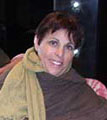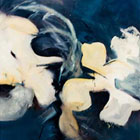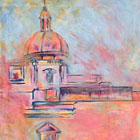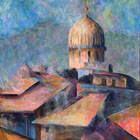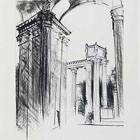JOAN F. VITALE
artwork | audio | 2008 update | galleries
artwork
audio 
(see also Making Art in Iowa)
- High school (57 sec. | 392KB): listen | read
- Late bloomer (56 sec. | 385KB): listen | read
- Cancer (58 sec. | 396KB): listen | read
- Paper & painting (59 sec. | 402KB): listen | read
- Growing (41 sec. | 284KB): listen | read
- Shaman (47 sec. | 324KB): listen | read
2008 update
We moved to Charlotte, NC, in 2005. My husband was ill and wanted be close to two of our children who lived here. My husband passed away in February 2007.
I have had a studio downtown for almost three years—Charlotte Art League, a gallery and working studio with about 18 other artists. I teach at the Art Institute of Charlotte. I continue to restore and conserve artworks. I have a passion for Argentine Tango; I dance weekly. I traveled to Europe in January 2008, a favorite place.
My work is regularly exhibited at Charlotte Art League. My recent works, acrylic paintings, are architectural. They are about line and color, displaying favorite pieces of places like Florence, Italy.
My work has changed, as much of my work was expressionist, figurative abstraction. The work is still expressionistic, but contains recognizable forms. After this set, I feel the need to return to the figurative abstractive work.
I have often been stuck, not making art. I question, examine my place. Always I continue but at a much slower pace than so many other prolific makers of art. My world is more fractured. I believe I must accept this about myself. I am very excited when someone purchases a work of mine. I experience their pleasure and connection to the work and that pleases me.
Life changes so drastically for me every few years. I know I like stimulation, but sometimes I feel it is too much change. But then, I am where I am supposed to be, so I tell myself.
audio text
High school
I didn't have art until I was in high school. I remember being at a drawing board, remember doing still life. Remember taking tempera and watercolor, and doing things like flowers or a stained glass window. There we were, thirty girls in a room, for what, forty-five minutes or an hour. I remember having this desire, and feeling like no one recognized it—like, and what do I do with this? All the arts were wonderful for me. And I never could convince my parents that it was that important; they were too busy. When I was doing the art in high school, I still remember a girl next to me who was very good—I was mediocre, and not feeling very confident, that was always a problem. I got As, but it wasn't like we talked about, do you want a career in art? So then I decided that the safe thing was to go to a school where they had art and fashion for college. And that's what I did.
Late bloomer
I'm a late bloomer when it comes to art. I realized after half a dozen years or more of marriage—I used to think, God, I wanted to do the art! I used to think about going back to school thinking, No, Marty—my husband—wouldn't like that. It wasn't part of my growing up that that's what I should be doing. So the rebel, the fighter in me, was really being suppressed. And maybe I did it to myself, but I think it was maybe a combination of me and my husband. The fight was starting. It took ten years before I went back to school. I let the art, the fine art, really go until probably 1985. I was always dabbling and creating stuff for people but not seriously until I went back to school. I realized that it was costing money which we didn't have, but if I didn't do that, it was either spend it on a shrink or get divorced or who knew what. But the school was a wonderful place for me. So I kept going.
Cancer
I guess it was '92, I had cancer. I got through the surgery fine. I would rather have the breast surgery than a lot of stuff that you deal with day-to-day that just bring you down and are struggles. I had an incredible experience. I was very up. I felt you have to have the good attitude. So when I went into surgery, I taped my chest and put on it, "measure twice, cut once," you know, and wore neon socks. I figured if we go in this laughing, we'll come out pretty good, you know? But it was fine. I didn't opt for any kind of corrective surgery or cosmetic surgery; I'm a purist about anatomy.
When I got to doing the artwork, I struggled the first semester—like, what should I be painting? I did some drawings of myself, because I had already done some studies a year before of just myself naked in charcoal, and thought, Do I have the nerve to put myself out there? I thought, If I can jump that chasm, I could do anything.
Paper & painting
I always wanted to do the paper, so I started there. I'd say it's formal work that's abstract, because it's about color, it's about texture, it's about fiber. It's what you see. I'm not drawing on it or doing anything to it. And it's very playful. I love process; I like how you get from here to there. So I like the steps in the papermaking.
The painting always starts with the drawing for me. I like the figure, so I go to the figure. I'm not a landscapist. I love the body; I like the forms in the body. So I'll go from that, or from some objects, like the umbrellas—the umbrellas to me is an anatomy, it's a skeleton, it's got a shell. So I start with the figure and then will abstract the figure, and then work in a very free way. And it's very automatic a lot of times—it goes from consciousness to subconscious. I just go back and forth. I see something developing, and I consciously develop. And then I let the subconscious take over, if you will, and just be very free.
Growing
Painting is the primary medium, but I enjoy prints. And I like making woodblocks. And actually, both in figurative and abstract. With the paper, I try new techniques all the time. That's the playfulness. There's always process, just cooking. It's recipes, it really is.
I feel like I'm just learning with paints. I don't feel I've even scratched the surface on where I could go with pigment. I'm still pretty traditional and safe. Like, I haven't done a lot of anything with impasto to really make thick paintings. I tend to work thin and layer. I like forms that go into other forms. So I haven't been as challenging with the painting. So I feel like I'm growing there.
Shaman
I don't put myself in this place, but the artist is a shaman—you know, an artist is that spiritual connection. But when I do the work, it's part of who I am—it's my soul. I'm working in an automatic way, and I'm really begging my soul to come forward. I'm asking that spirit within me to get out there on that canvas or in that work. Even if it's just the color and the forms that I might put together in the paper. So for me, it's very spiritual. It's an action of the soul, which is why if I don't do it, I'm not feeding myself, and I die. As it's coming forth from me, I'm also receiving. That to me is God—that's presence; that's sacrament; that's grace. It's incredible when it happens.

